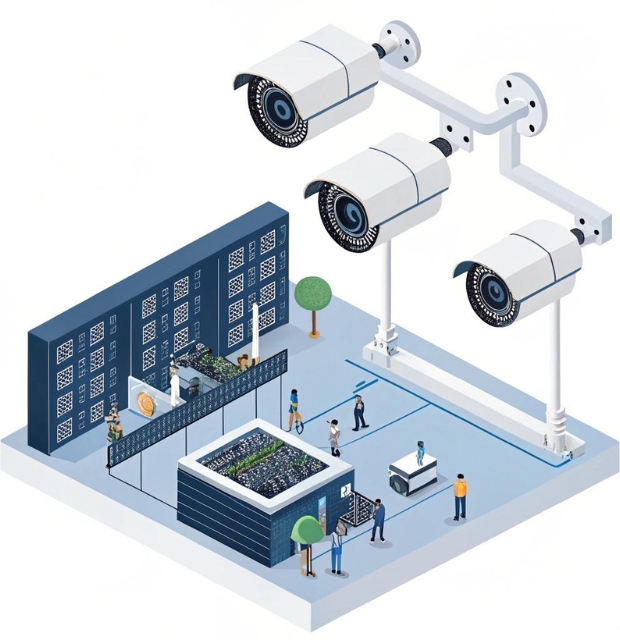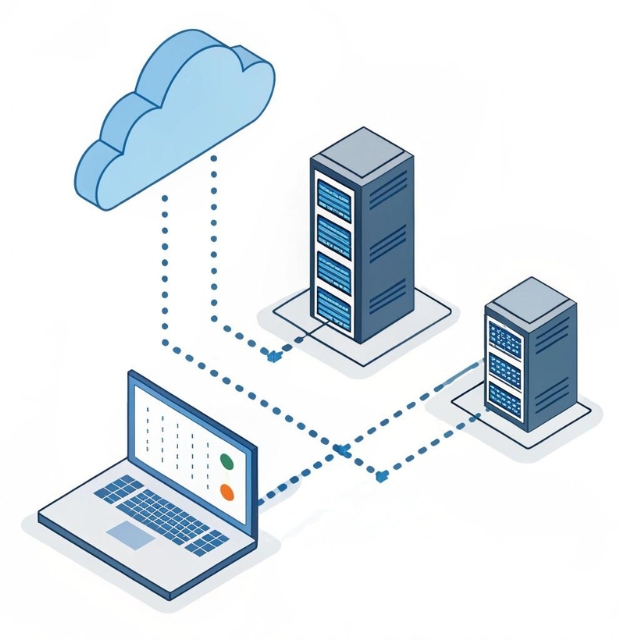Lights, Camera, Inference: Why Video Demands Speed
Surveillance cameras are always watching, but unless someone is reviewing the footage frame by frame, that data might as well be invisible. The promise of intelligent video analytics is that machines can see, interpret, and act on visual data in real time—but doing that at scale, across hundreds of streams, requires more than just clever software. It demands hardware muscle. That’s where AI accelerators come into play, enabling advanced intelligent video analytics to work with the speed and precision that modern applications demand.
Without the right compute layer, real-time vision becomes a bottleneck, not a breakthrough. Businesses, cities, and industrial facilities looking to harness video data need infrastructure that moves as fast as the world it’s trying to analyze.
The Secret Hardware Inside Smart Cameras
When someone talks about AI-powered surveillance, what they’re really referring to is a combination of cameras, software, and critically, a compact chip known as an AI accelerator. These tiny components—sometimes embedded directly in smart cameras—handle the heavy lifting of running neural networks, object detection models, and motion classification algorithms right at the edge.
In older setups, video would be streamed to a central server or cloud for analysis, adding latency and consuming bandwidth. But today, specialized chips like NPUs (neural processing units) or VPUs (vision processing units) can run inference locally, enabling instant detection of faces, vehicles, anomalies, or behaviors without needing to send raw video upstream.

Can Your Model Handle the Frame Rate?
Let’s say you’re analyzing a 4K video stream at 30 frames per second. That’s 30 opportunities every second to identify objects, behaviors, or risks. Multiply that by 100 cameras across a city or campus, and you’re quickly into the territory of millions of frames per hour. Not every processor is built for that.
AI models, especially deep convolutional neural networks used in video analytics, are compute-hungry. Running these models at scale requires dedicated hardware built for matrix operations—something that CPUs struggle with, and even GPUs can buckle under without optimization.
AI accelerators are designed specifically for this type of workload. Their architecture allows them to process video frames at high speed while keeping energy consumption low—making them ideal for embedded and edge applications.
From Cloud Latency to Edge Urgency
Imagine a transit station where a suspicious bag is left behind. Should the system send all the footage to the cloud for processing? Or should it recognize the potential risk instantly, trigger an alert, and notify security in real time?
This is the difference between cloud and edge processing—and AI accelerators make the latter possible. By deploying intelligence closer to the video source, you cut out the latency, avoid bandwidth congestion, and reduce dependence on centralized resources.
Intelligent video analytics thrives on immediacy. Whether it’s detecting congestion in traffic, unauthorized access in a facility, or safety violations on a factory floor, local inference powered by AI accelerators ensures that systems respond in milliseconds, not minutes.
To fully benefit from intelligent video analytics, it’s critical to use AI accelerators that support real-time edge-based processing.
Benchmark Showdown: Not All Accelerators Are Equal
AI accelerator isn’t a one-size-fits-all label. There are different types, each suited to specific environments, performance needs, and budget constraints. Choosing the wrong one can lead to poor throughput, system instability, or wasted energy.
- GPUs (Graphics Processing Units): Versatile and powerful, but consume lots of power and are best suited for centralized servers.
- ASICs (Application-Specific Integrated Circuits): Custom-built for specific AI tasks. Great for efficiency and speed but less flexible.
- FPGAs (Field Programmable Gate Arrays): Reconfigurable and ideal for custom video pipelines. Require more development effort.
- NPUs and VPUs: Designed specifically for vision and neural tasks. Excellent for edge deployments due to low power usage and compact design.
Understanding your deployment environment—whether it’s a smart pole in a city or a rack in a data center—will help determine the right AI accelerator for your intelligent video analytics solution.

The Optimization Game: Taming the Model for the Chip
Even the best AI accelerator can’t deliver results if the model it’s running is too large, slow, or inefficient. That’s why model optimization is a crucial step in preparing for deployment.
Techniques like quantization reduce the numerical precision of model weights, shrinking size and increasing speed with minimal accuracy loss. Pruning removes unnecessary nodes and parameters. Model architecture also matters. Lightweight models such as MobileNet, EfficientDet, or YOLOv5 are frequently used in real-time video environments because they strike a balance between speed and accuracy.
The Power of Microseconds: Why Time Is Everything
In environments where people’s safety or business continuity is at stake, every millisecond matters. A delayed detection in a warehouse could mean equipment damage. A lagging alert in a hospital could jeopardize patient care.
AI accelerators help systems move from a reactive state to a predictive one. By processing data as it comes in, they allow analytics platforms to identify patterns, predict issues, and generate alerts before problems escalate.
This capability is especially important in scenarios involving multiple video feeds, such as large campuses or multi-site industrial operations. With centralized processing, the delay in uploading, analyzing, and responding can be significant. But with distributed AI accelerators, insight is local—and instantaneous.
Beyond Surveillance: Smarter Video, Smarter Decisions
While most people associate video analytics with security, its applications are rapidly expanding. In retail, cameras powered by AI accelerators can analyze foot traffic, monitor shelf activity, and detect queue lengths. In manufacturing, they can check for safety compliance or product defects. In agriculture, they monitor livestock movement or crop conditions in real time.
These applications depend on the ability to process and interpret high volumes of visual data in challenging, sometimes remote, environments. AI accelerators make it feasible to deploy intelligent video analytics in places where cloud access is limited or power is constrained.
As a result, industries that once considered video intelligence out of reach are now embracing it at the edge—thanks to small, powerful chips capable of big insights.
AI Accelerators Are Eating the Video Pipeline
The modern video pipeline is no longer just a series of dumb lenses sending footage to a data lake. It’s an active, intelligent process—ingesting, analyzing, interpreting, and responding in real time. And AI accelerators are at the center of this transformation.
From initial frame capture to object recognition and behavior prediction, every step is being enhanced by hardware acceleration. The result: faster insights, more accurate detections, and lower energy costs per stream.
We’re entering a world where everything from a street lamp to a traffic signal may contain a chip capable of real-time video inference. The future of video isn’t just high resolution—it’s high intelligence, delivered at high speed.
Conclusion: The Future Is Accelerated Vision
What separates passive video from actionable intelligence is speed—and speed requires the right tools. AI accelerators are no longer niche components; they are essential building blocks of the intelligent video systems that power smart cities, protect infrastructure, and transform operations across industries.
If your organization is planning to scale intelligent video analytics, don’t just focus on the software layer. The real-time decisions you want to make depend on the hardware you choose.
From edge cameras to cloud data centers, the right AI accelerators ensure your systems aren’t just watching the world—but understanding it as it happens.
FAQs: AI Accelerators and Intelligent Video Analytics
1. What are AI accelerators in the context of video analytics?
AI accelerators are specialized hardware components—like GPUs, NPUs, and ASICs—designed to efficiently run machine learning models, especially those used in processing and analyzing video streams in real time.
2. How do AI accelerators improve intelligent video analytics?
They significantly boost the speed of inference for tasks like object detection, facial recognition, and activity monitoring, enabling real-time analysis without overwhelming CPUs or relying solely on cloud resources.
3. Why is edge-based video processing important?
Edge processing reduces latency, bandwidth usage, and reliance on cloud infrastructure, allowing faster decision-making and better performance in environments like smart cities, factories, and retail spaces.
4. Can AI accelerators be embedded directly in cameras?
Yes. Many smart cameras and edge devices now come with built-in AI accelerators, such as VPUs or NPUs, enabling them to process video locally without offloading data to external servers.
5. What’s the difference between GPUs and NPUs for video analytics?
GPUs are versatile and powerful but consume more energy, making them better for centralized systems. NPUs are optimized for neural processing tasks and are more energy-efficient, ideal for edge deployments.
6. What role does model optimization play in video analytics performance?
Optimization techniques like quantization and pruning reduce model size and increase speed, allowing AI models to run efficiently on resource-constrained AI accelerators.
7. How do AI accelerators help in real-time security monitoring?
They enable immediate analysis of video feeds to detect threats, unauthorized access, or unusual behavior, helping security teams act quickly and prevent incidents.
8. Are AI accelerators only used in surveillance systems?
No. They’re also used in retail, manufacturing, healthcare, agriculture, and transportation to extract insights from video data for operations, safety, and customer experience improvements.
9. What are the key factors to consider when selecting an AI accelerator?
Consider power consumption, processing speed, compatibility with your AI models, physical form factor, and whether your deployment is edge-based or centralized.